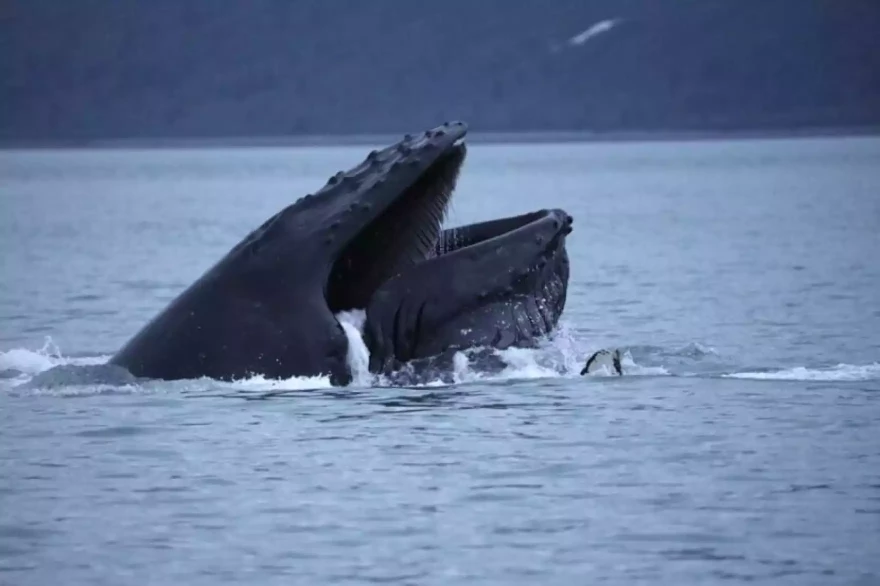Researchers say vessel strikes are a major threat for whales, including in the waters off Alaska. A new technology is aiming to change that by using AI, thermal imagining and marine observers.
Matson’s container ships bring cargo and cars from Tacoma, Washington to Anchorage, Kodiak and Dutch Harbor. The company has partnered with WhaleSpotter, a new system that helps ships detect whales, said Matson’s CEO Matt Cox.
“Every handful of years, we, unfortunately, do have a strike, and of course, we report that up,” Cox said. “But the hope is, this new technology will make that even more rare of an occurrence in the future.”
WhaleSpotter was introduced commercially about a year ago and is now used by a dozen companies, including some in Alaska, said Shawn Henry, the company’s chief executive officer. He said Matson is their latest partner and the first container ship company to use the system.
Danger of ship strikes
Researchers say ship strikes are one of the leading causes of whale deaths worldwide. In the Juneau area alone, at least nine humpback whales were hit by ships in the last five years, according to a local project called Juneau Whale HEALTH.
“Vessel strikes are a major threat to whales,” said Heidi Pearson, a professor of marine biology at the University of Alaska Southeast and a principal investigator for the project. “Most ship strikes go undocumented. Especially if it's a large vessel, they could hit a whale and not even know it.”
Andy Szabo, the director of conservation and research organization the Alaska Whale Foundation, said ship strikes are especially prominent in the areas frequented by cruise and cargo ships.
“Whenever you're running high-speed, large boats through whale waters, that increases the likelihood of strikes,” he said.
Humpback whales are the most prone to strikes because they often swim close to the surface and close to shore, Szabo said.
The harm from the vessel strikes is compounding on top of other challenges whales face, he said. About a year ago, a marine heatwave in the Pacific known as the Blob disrupted ecosystems along the West Coast of the U.S., causing thousands of humpbacks to starve, Szabo said.
He said the population still has not recovered.
“They're not doing great at all,” Szabo said. “So when you have that, and then you overlay on top of that vessel strikes, even if it's not a lot of animals, it can have an impact.”
The new whale-detection system
WhaleSpotter technology is designed to alert ship crews when there is a whale nearby and give them an opportunity to change course or stop.
“We are enabling a vessel to detect a whale well ahead of the amount of time it needs to make a turn or slow down,” said Henry with WhaleSpotter.
Thermal cameras track temperature changes in a four-nautical-mile radius around a ship, Henry said. Then, the technology uses artificial intelligence to determine which images likely captured whales. Remote marine mammal observers – real people watching the data feed from elsewhere – do the last checks. Then the system sends an alert to crews about a possible whale nearby.

The Woods Hole Oceanographic Institution in Massachusetts has been developing the technology for the last 15 years, Henry said. The institute granted WhaleSpotter a license to sell the technology, and the company has been working with different clients for about a year.
“We have a number of different other types of vessels that are using the product,” Henry said. “Some of them – vessel strike avoidance, some of them for marine operations like cable laying and pile driving.”
Cox, the CEO of Matson, said the company tested the technology on their ships. He said the trials showed that the system is effective at detecting individual whales and pods, and sometimes even the direction the whale is traveling in.
“We've had cases where those whale detections have been spotted, and we've been able to navigate around the pod or the individual whale to lessen the chances of a strike,” Cox said. “It's worked really well.”
Now Cox said Matson plans to have it on all three of its Alaska ships. He said the crews are excited about it.
There's genuine enthusiasm and excitement on board the vessels,” he said.
Pearson, at the University of Alaska Southeast, said the WhaleSpotter technology can be a game changer for whales, vessels and their crews and passengers.
“Of course, if a whale gets hit, it's awful for the whale, but it can also damage vessels. Whale strikes have also been known to cause damage to human passengers on the boat,” she said. “So anything we can do to mitigate that protects whales and humans as well.”
Szabo, with the Alaska Whale Foundation, said that outfitting ships with technology to detect whales is a good first step, but he wants to know more about what the crews will do with that information.
He said that if the whale is too close, the ship might not have enough time to turn. And if the whale is too far and is moving, the original location might be irrelevant. Plus, he said, if there are many whales in the area, it can be unclear what the best course of action for the ship might be.
Still, Szabo said he is optimistic about the technology.
“It can't be a bad thing,” Szabo said. “I just hope that there is sufficient effort put into the whole training and procedures and protocol side of things as well, to make it as useful as it could be.”

